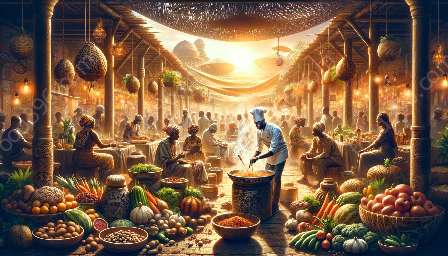Delve into the rich and diverse history of Moroccan cuisine, an integral part of African and global culinary traditions. From its origins to popular dishes, explore the flavorful tapestry of Moroccan culinary heritage.
Origins of Moroccan Cuisine
Moroccan cuisine is a reflection of the country's diverse history, blending culinary traditions from Berber, Arab, Moorish, and Ottoman influences. The indigenous Berbers introduced ingredients such as couscous, olives, and preserved lemons, creating a foundation for the flavorful cuisine that exists today.
Influences on Moroccan Cuisine
The Arab and Moorish invasions brought a myriad of spices, such as cumin, cinnamon, and saffron, which continue to play a vital role in Moroccan cooking. The Ottoman Empire's influence introduced a variety of meat dishes, resulting in a fusion of flavors that characterizes Moroccan cuisine.
Key Ingredients and Dishes
Moroccan cuisine is renowned for its use of aromatic spices, including cumin, cinnamon, paprika, and ginger, which impart depth and complexity to dishes. Traditional Moroccan dishes such as tagine, a slow-cooked stew often prepared with lamb or chicken, showcase the distinctive flavors and cooking techniques that define Moroccan cuisine.
The Importance of Souks
The bustling markets or souks play a crucial role in the distribution of spices, fruits, and vegetables, creating a vibrant and dynamic food culture in Morocco. The availability of fresh, high-quality ingredients is fundamental to the authentic flavors of Moroccan cuisine.
Ingredients and Techniques
Moroccan cuisine also features the use of nuts, particularly almonds and pistachios, as well as the incorporation of honey and dates to create delectable desserts, adding a sweet contrast to savory dishes. The unique cooking vessel known as the tagine, which helps to infuse flavors and produce tender, succulent meats, is a hallmark of traditional Moroccan cooking.
Regional Variations
Across various regions of Morocco, culinary traditions and dishes differ, influenced by local ingredients and cultural practices. The coastal regions are celebrated for their seafood-based dishes, while the interior is known for hearty and aromatic tagines. In the north, the Andalusian influence is evident in delicate pastries and flavored teas.
Global Influence and Popularity
Moroccan cuisine has gained global recognition for its bold flavors and diverse dishes. The combination of sweet and savory flavors, as well as the use of intricate spices, has captivated food enthusiasts worldwide, leading to the proliferation of Moroccan restaurants and the integration of Moroccan flavors in international cuisine.
Celebratory and Festive Cuisine
Special occasions and festivals in Morocco are marked by the preparation of traditional dishes, such as couscous with seven vegetables, symbolic of abundance and prosperity, and pastilla, a savory and sweet pie traditionally associated with celebrations. These dishes embody the intricate and meaningful traditions of Moroccan culinary heritage.

